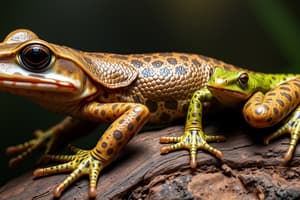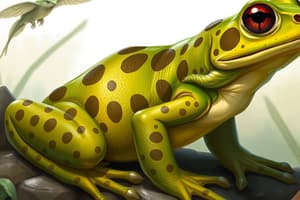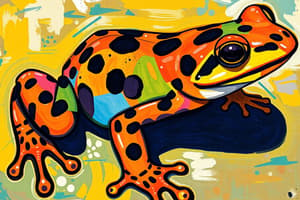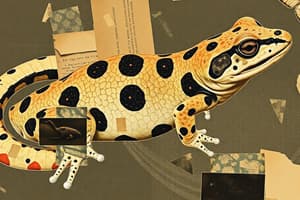Podcast
Questions and Answers
What is the primary characteristic of an amphibian's skin?
What is the primary characteristic of an amphibian's skin?
- Furry
- Scaly
- Dry and rough
- Moist and smooth (correct)
What is the primary source of food for frogs?
What is the primary source of food for frogs?
- Small mammals
- Insects, worms, and other invertebrates (correct)
- Fish and other aquatic animals
- Plants and algae
What is the stage of a frog's life cycle that undergoes metamorphosis?
What is the stage of a frog's life cycle that undergoes metamorphosis?
- Adult
- Tadpole (correct)
- Larva
- Egg
What is a common defense mechanism used by frogs?
What is a common defense mechanism used by frogs?
What is a major threat to frog populations worldwide?
What is a major threat to frog populations worldwide?
What is a conservation effort to protect frog populations?
What is a conservation effort to protect frog populations?
Flashcards are hidden until you start studying
Study Notes
Characteristics
- Amphibians, belonging to the order Anura
- Typically have a moist, smooth skin
- Long, jumping legs and webbed feet
- No tail in adult stage (apart from a few species)
- Carnivorous, feeding on insects, worms, and other invertebrates
Habitat and Distribution
- Found in a wide range of aquatic and terrestrial environments
- Inhabit ponds, lakes, rivers, forests, and grasslands
- Distributed across the globe, except Antarctica
- Most species are found in tropical and subtropical regions
Life Cycle
- Eggs are laid in water, hatch into larvae (tadpoles)
- Tadpoles undergo metamorphosis, developing into adult frogs
- Adult frogs reproduce, starting the cycle again
Defense Mechanisms
- Camouflage and hiding to avoid predators
- Toxic secretions from skin to deter predators
- Some species can play dead (thanatosis) or release a foul odor
Communication
- Use vocalizations (croaks, chirps, etc.) to communicate
- Visual signals, such as postures and color changes, also used
- Some species use seismic signals, vibrating the ground to communicate
Conservation Status
- Many species are threatened or endangered due to habitat destruction, pollution, and disease
- Chytridiomycosis, a fungal disease, has devastated frog populations worldwide
- Conservation efforts, such as habitat protection and captive breeding, are underway to protect frog populations
Characteristics of Frogs
- Belong to the order Anura
- Have moist, smooth skin
- Characterized by long, jumping legs and webbed feet
- Adults have no tail, except for a few species
Habitat and Distribution
- Found in a wide range of aquatic and terrestrial environments
- Inhabit ponds, lakes, rivers, forests, and grasslands
- Distributed across the globe, except Antarctica
- Majority of species are found in tropical and subtropical regions
Life Cycle
- Eggs are laid in water, which hatch into larvae (tadpoles)
- Tadpoles undergo metamorphosis, developing into adult frogs
- Adult frogs reproduce, starting the cycle again
Defense Mechanisms
- Use camouflage and hiding to avoid predators
- Have toxic secretions from skin to deter predators
- Some species can play dead (thanatosis) or release a foul odor
Communication
- Use vocalizations (croaks, chirps, etc.) to communicate
- Visual signals, such as postures and color changes, are also used
- Some species use seismic signals, vibrating the ground to communicate
Conservation Status
- Many species are threatened or endangered due to habitat destruction, pollution, and disease
- Chytridiomycosis, a fungal disease, has devastated frog populations worldwide
- Conservation efforts, such as habitat protection and captive breeding, are underway to protect frog populations
Studying That Suits You
Use AI to generate personalized quizzes and flashcards to suit your learning preferences.




